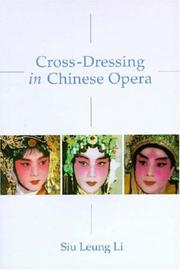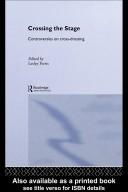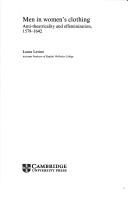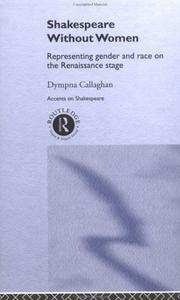| Listing 1 - 10 of 10 |
Sort by
|
Book
ISBN: 9780295995106 Year: 2016 Publisher: Seattle University of Washington Press
Abstract | Keywords | Export | Availability | Bookmark
 Loading...
Loading...Choose an application
- Reference Manager
- EndNote
- RefWorks (Direct export to RefWorks)
Kabuki --- Actors --- Female impersonators --- J6835 --- Cross-dressers (Female impersonators) --- Crossdressers (Female impersonators) --- Drag queens --- Impersonators, Female --- Impersonators of women --- Queens, Drag --- Stage actors --- Theater actors --- Theatrical actors --- History. --- Japan: Performing arts and entertainment -- kabuki --- Artists --- Entertainers --- Theater --- Persons --- History
Book
ISBN: 0295806249 9780295806242 9780295995106 0295995106 Year: 2015 Publisher: Seattle
Abstract | Keywords | Export | Availability | Bookmark
 Loading...
Loading...Choose an application
- Reference Manager
- EndNote
- RefWorks (Direct export to RefWorks)
Kabuki is well known for its exaggerated acting, flamboyant costumes and makeup, and unnatural storylines. The onnagata, usually male actors who perform the roles of women, have been an important aspect of kabuki since its beginnings in the 17th century. In a "labyrinth" of gendering, the practice of men playing women's roles has affected the manifestations of femininity in Japanese society. In this case study of how gender has been defined and redefined through the centuries, Maki Isaka examines how the onnagata's theatrical gender "impersonation" has shaped the concept and mechanisms of femininity and gender construction in Japan. The implications of the study go well beyond disciplinary and geographic cloisters.
Kabuki --- Actors --- Female impersonators --- Cross-dressers (Female impersonators) --- Crossdressers (Female impersonators) --- Drag queens --- Impersonators, Female --- Impersonators of women --- Queens, Drag --- Stage actors --- Theater actors --- Theatrical actors --- Artists --- Entertainers --- Theater --- History. --- Persons
Multi
ISBN: 1626568111 9781626568082 1626568081 9781626568112 9781626568075 Year: 2016 Publisher: Oakland Berrett-Koehler Publishers
Abstract | Keywords | Export | Availability | Bookmark
 Loading...
Loading...Choose an application
- Reference Manager
- EndNote
- RefWorks (Direct export to RefWorks)
Self-realization in women --- Self-confidence --- Female impersonators --- Cross-dressers (Female impersonators) --- Crossdressers (Female impersonators) --- Drag queens --- Impersonators, Female --- Impersonators of women --- Queens, Drag --- Actors --- Assurance, Self --- Self-assurance --- Confidence --- Emotions --- Self-reliance --- Women --- Psychology --- E-books --- Persons

ISBN: 0203057090 1283962942 1136569286 9780203057094 9781560232858 1560232854 1560232846 1560232854 9781560232841 9781136569289 9781136569425 1136569421 9781136569357 1136569359 9781283962940 Year: 2004 Publisher: New York Harrington Park Press
Abstract | Keywords | Export | Availability | Bookmark
 Loading...
Loading...Choose an application
- Reference Manager
- EndNote
- RefWorks (Direct export to RefWorks)
Examine the cultural and political implications of male-to-female gender performance! The Drag Queen Anthology: The Absolutely Fabulous but Flawlessly Customary World of Female Impersonators examines the phenomena of male-to-female gender performance and the people who live it. This provocative collection of original essays explores the possibilities, limitations, ironies, and controversies surrounding men who perform as women to an audience that knows the truth but celebrates the illusion. The book's contributors call on extensive backgrounds in sociology, anthropology, theater, literature.
Transvestism. --- Transvestites. --- Female impersonators. --- Crossdressers --- Femmiphilliacs --- Transvestites --- Persons --- Cross-dressers (Female impersonators) --- Crossdressers (Female impersonators) --- Drag queens --- Impersonators, Female --- Impersonators of women --- Queens, Drag --- Actors --- Transvestism --- Crossdressing --- Eonism --- Psychosexual disorders --- Paraphilias --- Drag queens. --- Drag performance. --- Cross-dressing --- Cross-dressers --- Drag kinging (Performing arts) --- Drag queening (Performing arts) --- Performing arts --- Entertainers
Book
ISBN: 0520972236 0520301668 Year: 2019 Publisher: Oakland University of California Press
Abstract | Keywords | Export | Availability | Bookmark
 Loading...
Loading...Choose an application
- Reference Manager
- EndNote
- RefWorks (Direct export to RefWorks)
Learn more at www.luminosoa.org.Impersonations: The Artifice of Brahmin Masculinity in South Indian Dance centers on an insular community of Smarta Brahmin men from the Kuchipudi village in Telugu-speaking South India who are required to don stri-vesam (woman's guise) and impersonate female characters from Hindu religious narratives. Impersonation is not simply a gender performance circumscribed to the Kuchipudi stage, but a practice of power that enables the construction of hegemonic Brahmin masculinity in everyday village life. However, the power of the Brahmin male body in stri-vesam is highly contingent, particularly on account of the expansion of Kuchipudi in the latter half of the twentieth century from a localized village performance to a transnational Indian dance form. This book analyzes the practice of impersonation across a series of boundaries-village to urban, Brahmin to non-Brahmin, hegemonic to non-normative-to explore the artifice of Brahmin masculinity in contemporary South Indian dance.
Brahmans --- Female impersonators --- Gender identity in dance --- Kuchipudi (Dance) --- SOCIAL SCIENCE / Anthropology / General. --- Dance --- Cross-dressers (Female impersonators) --- Crossdressers (Female impersonators) --- Impersonators, Female --- Impersonators of women --- Persons --- Brahmins --- Caste --- Ethnology --- Hindus --- Kuchipudi Bharatam --- Social life and customs. --- Social aspects --- 20th century. --- brahmin to non brahmin. --- female characters. --- gender performance. --- hindu religious narratives. --- impersonation. --- kuchipudi village. --- localized village performance. --- male body. --- masculinity. --- men. --- practice of impersonation. --- smarta brahmin. --- south india. --- stage. --- stri vesham. --- telugu. --- transnational indian dance form. --- village to urban.

ISBN: 1282705946 9786612705946 9882200931 9789882200937 9622096034 9789622096035 9622098320 Year: 2003 Publisher: Hong Kong : Hong Kong University Press,
Abstract | Keywords | Export | Availability | Bookmark
 Loading...
Loading...Choose an application
- Reference Manager
- EndNote
- RefWorks (Direct export to RefWorks)
Informed by queer and feminist theories, this book offers a critical and historical reinterpretation of theatrical cross-dressing in Chinese culture embodied in various discourses, texts and artifacts from the eighth century to the present time.
Operas, Chinese --- Transvestism. --- Male impersonators --- Female impersonators --- Sex role --- Theater --- Gender role --- Sex (Psychology) --- Sex differences (Psychology) --- Social role --- Gender expression --- Sexism --- Cross-dressers (Female impersonators) --- Crossdressers (Female impersonators) --- Drag queens --- Impersonators, Female --- Impersonators of women --- Queens, Drag --- Actors --- Cross-dressers (Male impersonators) --- Crossdressers (Male impersonators) --- Drag kings --- Impersonators, Male --- Impersonators of men --- Kings, Drag --- Actresses --- Transvestism --- Crossdressing --- Eonism --- Psychosexual disorders --- Beijing operas --- Chinese operas --- Ching chü --- Jingju --- Operas, Beijing --- Operas, Peking --- Peking operas --- Pʻing chü (Chinese operas) --- Chinese drama --- Analysis, appreciation. --- Persons --- Paraphilias --- Cross-dressing. --- Gender roles --- Gendered role --- Gendered roles --- Role, Gender --- Role, Gendered --- Role, Sex --- Roles, Gender --- Roles, Gendered --- Roles, Sex --- Sex roles --- Gender identity --- Costume --- History and criticism. --- History.

ISBN: 0415062691 Year: 1993 Publisher: London Routledge
Abstract | Keywords | Export | Availability | Bookmark
 Loading...
Loading...Choose an application
- Reference Manager
- EndNote
- RefWorks (Direct export to RefWorks)
film --- Film --- Acting --- Female impersonators. --- Feminism and theater. --- Impersonation. --- Male impersonators. --- Sex role in literature. --- Theater and society. --- Theater --- Transvestism. --- Casting. --- 792 --- 82-2 --- Theater. Theaterwetenschap. Toneel --- Toneel. Drama --- 82-2 Toneel. Drama --- 792 Theater. Theaterwetenschap. Toneel --- Female impersonators --- Feminism and theater --- Impersonation --- Male impersonators --- Sex role in literature --- Theater and society --- Transvestism --- Crossdressing --- Eonism --- Psychosexual disorders --- Casting (Performing arts) --- Actors --- Society and theater --- Cross-dressers (Male impersonators) --- Crossdressers (Male impersonators) --- Drag kings --- Impersonators, Male --- Impersonators of men --- Kings, Drag --- Actresses --- Comedy --- Imitation --- Theater and feminism --- Cross-dressers (Female impersonators) --- Crossdressers (Female impersonators) --- Drag queens --- Impersonators, Female --- Impersonators of women --- Queens, Drag --- Casting --- Production and direction --- Social status --- Social aspects --- 82-2 Drama. Plays --- Drama. Plays --- 792 Theatre. Stagecraft. Dramatic performances --- Theatre. Stagecraft. Dramatic performances --- Paraphilias --- Persons
Book
ISBN: 9781551525198 1551525194 1551525208 Year: 2013 Publisher: Vancouver Arsenal Pulp Press
Abstract | Keywords | Export | Availability | Bookmark
 Loading...
Loading...Choose an application
- Reference Manager
- EndNote
- RefWorks (Direct export to RefWorks)
"This latest addition to the Queer Film Classics series is an homage to Paris Is Burning, Jennie Livingston's brilliant and award-winning 1991 documentary that captures the energy, ambition, wit, and struggle of African-American and Latino participants in the 1980s New York drag ball scene. An unlikely hit when it was first released, the film is a lively, touchingly empathetic portrait of urban drag culture, introducing such performers as Willi Ninja, Pepper LaBeija, and Angie Xtravaganza. Paris is Burning generated enthusiastic buzz from audiences and critics, as well as impassioned debate: did the film present a subversive perspective on the crass values of the 1980s, or did it exploit its subjects and pander to privileged movie audiences? Regardless, the film is considered one of the key films of the New Queer Cinema, and resonates with audiences to this day. Author Lucas Hilderbrand contextualizes the film within the longer history of drag balls, the practices of documentary, the fervor of the culture wars, and issues of gender, sexuality, race, and class."--
Gay men in motion pictures --- Gay men --- Cross-dressing in motion pictures --- Cross-dressers --- Drag queens --- Drag queens in motion pictures --- Drag balls --- Female impersonators in motion pictures --- Female impersonators --- 799.5 --- 798.53 --- LGBTQ+ (lesbian, gay, bisexual, transgender, queer and others) --- Afro-Amerikanen --- homoseksualiteit --- New York --- Latino's --- drag --- dragshow --- vogue (voguen) --- documentaire --- film --- Transvestism in motion pictures --- Motion pictures --- Gays, Male --- Homosexuals, Male --- Male gays --- Male homosexuals --- Urnings --- Gays --- Men --- Cross-dressers (Female impersonators) --- Crossdressers (Female impersonators) --- Impersonators, Female --- Impersonators of women --- Persons --- Ball culture (Sexual minority culture) --- House ballroom scene (Sexual minority culture) --- Contests --- Sexual minority culture --- Crossdressers --- Transvestites --- Social life and customs --- filmgenres en -motieven, documentaire films --- Paris is burning (Motion picture) --- Queens, Drag --- Entertainers

ISBN: 0521455073 052146627X Year: 1994 Volume: 5 Publisher: Cambridge Cambridge University press
Abstract | Keywords | Export | Availability | Bookmark
 Loading...
Loading...Choose an application
- Reference Manager
- EndNote
- RefWorks (Direct export to RefWorks)
English literature --- Drama --- anno 1600-1699 --- anno 1500-1599 --- Clothing and dress in literature --- English drama --- Female impersonators --- Literature and society --- Masculinity (Psychology) in literature --- Sex role in literature --- Theater and society --- Women in literature --- Vêtements dans la littérature --- Théâtre anglais --- Littérature et société --- Masculinité (Psychologie) dans la littérature --- Rôle selon le sexe dans la littérature --- Théâtre et société --- Femmes dans la littérature --- History and criticism --- History --- Histoire et critique --- Histoire --- 820-2 "15/16" --- Engelse literatuur: toneel; drama--?"15/16" --- 820-2 "15/16" Engelse literatuur: toneel; drama--?"15/16" --- Masculinity in literature. --- Vêtements dans la littérature --- Théâtre anglais --- Littérature et société --- Masculinité (Psychologie) dans la littérature --- Rôle selon le sexe dans la littérature --- Théâtre et société --- Femmes dans la littérature --- Masculinity in literature --- Woman (Christian theology) in literature --- Women in drama --- Women in poetry --- Actors --- Society and theater --- Theater --- Literature --- Literature and sociology --- Society and literature --- Sociology and literature --- Sociolinguistics --- Cross-dressers (Female impersonators) --- Crossdressers (Female impersonators) --- Drag queens --- Impersonators, Female --- Impersonators of women --- Queens, Drag --- Costume in literature --- Social status --- Social aspects --- Persons

ISBN: 0415202310 0415202329 9780415202329 1134633122 1280317434 0203457722 9780203457726 9780415202312 9786610317431 6610317437 9781134633128 9781134633074 1134633076 9781134633111 1134633114 9781280317439 Year: 2000 Publisher: London Routledge
Abstract | Keywords | Export | Availability | Bookmark
 Loading...
Loading...Choose an application
- Reference Manager
- EndNote
- RefWorks (Direct export to RefWorks)
Shakespeare Without Women is a controversial study of female impersonation and the connections between dramatic and political representation in Shakespeare's plays.
Africans in literature --- Blacks in literature --- Female impersonators --- Feminism and theater --- Theater and society --- Theater --- Women in literature --- Woman (Christian theology) in literature --- Women in drama --- Women in poetry --- Dramatics --- Histrionics --- Professional theater --- Stage --- Theatre --- Performing arts --- Acting --- Actors --- Society and theater --- Theater and feminism --- Cross-dressers (Female impersonators) --- Crossdressers (Female impersonators) --- Drag queens --- Impersonators, Female --- Impersonators of women --- Queens, Drag --- Negroes in literature --- History --- Casting --- Social status --- Social aspects --- Shakespeare, William, --- Šekspir, Vil'jam --- Characters --- Africans. --- Women. --- Political and social views. --- Stage history --- Sociology of culture --- Theatrical science --- Sociology of the family. Sociology of sexuality --- Shakespeare, William --- anno 1400-1499 --- anno 1500-1599 --- Great Britain --- Africans in literature. --- Blacks in literature. --- Women in literature. --- Women --- Africans --- To 1625 --- Political and social views --- England --- 16th century --- 17th century --- Shakespeare, William, - 1564-1616 - Characters - Africans. --- Shakespeare, William, - 1564-1616 - Stage history - To 1625. --- Shakespeare, William, - 1564-1616 - Political and social views. --- Theater - England - Casting - History - 16th century. --- Theater - England - Casting - History - 17th century. --- Feminism and theater - England - History. --- Female impersonators - England - History. --- Rheater and society - England - History. --- Shakespear, William, --- Shakspeare, William, --- Šekʻspiri, Uiliam, --- Saixpēr, Gouilliam, --- Shakspere, William, --- Shikisbīr, Wilyam, --- Szekspir, Wiliam, --- Šekspyras, --- Shekspir, Vilʹi︠a︡m, --- Šekspir, Viljem, --- Tsikinya-chaka, --- Sha-shih-pi-ya, --- Shashibiya, --- Sheḳspir, Ṿilyam, --- Shaḳspir, Ṿilyam, --- Syeiksŭpʻio, --- Shekspir, V. --- Szekspir, William, --- Shakespeare, Guglielmo, --- Shake-speare, William, --- Sha-ō, --- Şekspir, --- Shekspir, Uiliam, --- Shekspir, U. --- Šekspir, Vilijam, --- Ṣēkspiyar, Viliyam, --- Shakspir, --- Shekspyr, Vyli︠e︡m, --- Şekspir, Velyam, --- Ṣēkspiyar, Villiyam, --- Shēkʻspʻiyr, Vlilliam, --- Ṣēkspiyar, --- Ṣēkspiyar Mahākavi, --- Ṣēkspiyar Mahākaviya, --- Sheḳspier, Ṿilyam, --- Shēkʻspir, --- Shakespeare, --- Śeksper, --- Шекспир, Вильям, --- Шекспир, Уильям, --- שייקספיר, וויליאם, --- שייקספיר, וו., --- שיקספיר, וויליאם --- שיקספיר, ויליאם --- שיקספיר, ויליאם, --- שכספיר, ויליאם, --- שכספיר, וילים, --- שכספיר, ו׳ --- שעפקספיר, וויליאם, --- שעקספיער, וויליאם --- שעקספיער, וויליאם, --- שעקספיער, ווילליאם --- שעקספיער, וו., --- שעקספיר --- שעקספיר, וו --- שעקספיר, וויליאם, --- שעקספיר, וויליאמ --- שעקספיר, ווילליאם --- שעקספיר, ווילליאם, --- שעקספיר, וו., --- שעקספיר, װיליאם, --- שעקספיר, װילליאם, --- שעקספיר, װ., --- שעקספער --- שעקספער, וויליאמ --- שקספיר --- שקספיר, וו --- שקספיר, וויליאם --- שקספיר, וויליאם, --- שקספיר, ווילים, --- שקספיר, וילאם --- שקספיר, ויליאם --- שקספיר, ויליאם, --- שקספיר, ויליים, --- שקספיר, וילים --- שקספיר, וילים, --- شاكسبير، وليم --- شاكسپير، وليم --- شكسبير، وليام --- شكسبير، وليم --- شكسبير، وليم، --- شكسبير، و. --- شكسپير، وليم --- شكسپير، ويليام --- شيكسبير، وليام --- شيكسبير، وليام.، --- شيكسبير، وليم --- شکسبير، وليم --- وليم شکسبير --- 沙士北亞威廉姆, --- 沙士比亞威廉姆, --- 莎士比亞威廉姆, --- 莎士比亞威廉, --- 莎士比亞, --- Persons --- History. --- Black people in literature. --- Race --- Gender --- Renaissance --- Book
| Listing 1 - 10 of 10 |
Sort by
|

 Search
Search Feedback
Feedback About UniCat
About UniCat  Help
Help News
News